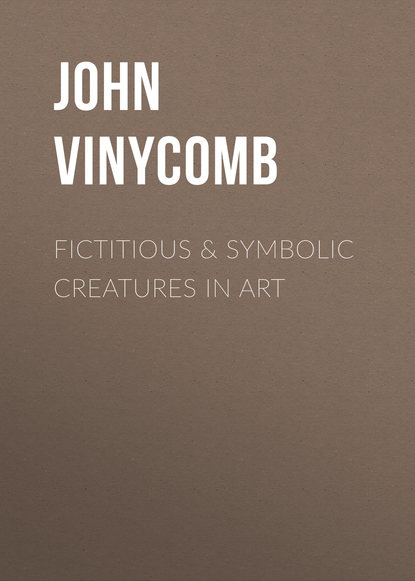 Полная версия
Полная версияFictitious & Symbolic Creatures in Art
“Few eyes,” says Sir Thomas Browne, “have escaped the picture of a mermaid with a woman’s head above and a fish’s extremity below.” In those old days when reading and writing were rare accomplishments, pictured signboards served to give “a local habitation and a name” to hostelries and other places of business and resort. Among the most celebrated of the old London taverns bearing this sign,31 that in Bread Street stands foremost.
We find this “Mermayde” mentioned as early as 1464. In 1603 Sir Walter Raleigh established a literary club in this house, and here Shakespeare, Ben Jonson, and the choice intellectual spirits of the time used to meet, and there took place those wit combats which Beaumont has commemorated and Fuller described. It is frequently alluded to by Beaumont and Fletcher in their comedies, but best known is that quotation from a letter of Beaumont to Ben Jonson:
“What things have we seenDone at the Mermaid? heard words that have beenSo nimble and so full of subtle flame,As if that any one from whence they cameHad meant to put his whole wit in a jest,And had resolved to live a fool the restOf his dull life; then when there had been thrownWit able enough to justify the townFor three days past; wit that might warrant beFor the whole city to talk foolishly,Till that were cancell’d; and when that was gone,We left an air behind us, which aloneWas able to make the next two companies(Right witty, though but downright fools) more wise.”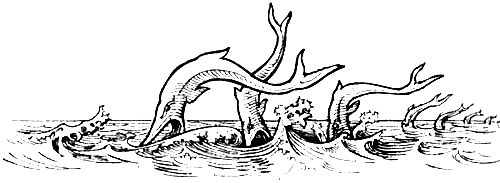
The Dolphin of Legend and of Heraldry
“… his delightsWere dolphin-like; they showed his back aboveThe element they lived in.”“Anthony and Cleopatra,” Act v. sc. 2.As the Lion is the king of beasts, the Eagle the king of birds, so in similar heraldic sense the Dolphin is king of fishes. His position in legend is probably due to his being one of the biggest and boldest creatures of the sea that passed the Pillars of Hercules into the Mediterranean Sea. Pliny (Book ix. ch. 8) calls it “The swiftest of all other living creatures whatsoever, and not of sea fish only, is the dolphin; quicker than any fowle, swifter than the arrow shot from a bow.”
The dolphin, of which there are several varieties, enjoys a pretty wide geographical distribution, being found in the Arctic seas, the Atlantic Ocean, and indeed of all seas. It was well known to the ancients and furnished the theme of many a fabulous story.

The Dolphin.
The common dolphin (Delphinus Delphis) the true hieros ichthus, is only rarely met with on the British coast. Its length is usually seven or eight feet, though some specimens have been found to measure ten feet. Its back is almost straight, or only slightly elevated; its colour is dusky black above and whitish beneath. Its pectorals or flappers, which are placed low in the sides, are well developed, and a dorsal fin, which is somewhat short, is much elevated. Its tail is broad and notched in the centre and expanded horizontally—not vertically as in most other fishes—by the help of which it makes its peculiar leaps over the surface of the water and at the same time takes its breath.
Unlike its near relatives the porpoises, who haunt the coast, dolphins live far out at sea, and are generally mistaken for porpoises. The long-snouted dolphin feeds on pelagic fishes. The short-nosed porpoise likes salmon and mackerel, robs the fishermen’s nets, and even burrows in the sand in search of odds and ends. The dolphin is the sea-goose. The porpoise is the sea-pig; he is the porc-poisson, the porc-pois, or sea-hog.
The convex snout of the dolphin is separated from the forehead by a deep furrow; the muzzle is greatly extended, compressed, and much attenuated especially towards the apex, where it terminates in a rather sharp-pointed beak. The French name bec d’oie, from the great projection of its nose or beak, has led to its adoption in the arms of English families of the name of Beck. The dolphin is an elegant and swift swimmer, and capable of overtaking the swiftest of the finny tribe. Because the creature is noted for its swiftness it has been adopted in the arms of Fleet.
The dolphin is able to hold his own against nearly all others of his size and weight, and even some of the larger cetaceans only come off second best in an encounter with the dolphin. He is voracious, gluttonous, and ever on the look out for something to turn up, hunting his prey with great persistency and devouring it with avidity. He has been not inaptly styled “the plunderer of the deep.”
The destructive character of the dolphin amongst the various tribes of fish is not lessened when we examine its formidable jaws studded with an immense number of interlocking teeth. Notwithstanding its rapacious habits and the variety of its diet it was in England formerly regarded as a royal fish, and its flesh held in high estimation. Old chroniclers have frequent entries of dolphins being caught in the Thames, thus: “3 Henry V.—Seven dolphins came up the Thames, whereof four were taken.” “14th Richard II.—On Christmas Day one was taken at London Bridge, being ten feet long, and a monstrous grown fish.” (Delalune’s “Present State of London,” 1681.) The early fathers of the Church deemed “all fish that swam in the sea”; the dolphin was therefore eaten in Lent. He is, however, a mammal, not a fish, and though an air-breathing creature he lives and dies in the ocean. But one is brought forth at a birth, and between the old and young of their kind, as in the case of all marine animals, a strong affection exists.
Travellers’ tales are notoriously hard of belief, and must be taken cum grano salis. We learn from Sir Thomas Herbert, an early voyager, that when he was on the coast of Sanquehar, a large kingdom on the east side of the Cape of Good Hope, he “saw there great numbers of dolphins,” of which he says: “They much affect the company of men, and are nourished like men; they are always constant to their mates, tenderly affected to their parents, feeding and defending them against hungry fishes when they are old,” and much more information equally astonishing.
A story is related of a man who once went to a mufti and asked him whether the flesh of the sea-pig (the dolphin) was lawful food. Without any hesitation the mufti declared that pig’s flesh was unlawful at all times and under all circumstances. Some time after another person submitted the question to the same authority, whether the fish of the sea, called the sea-pig, was lawful food. The mufti replied: “Fish is lawful food by whatever name it may be called.”
Classic Fable and Mediæval Legend have shed a halo of romantic interest around the dolphin which cleaves to it even to the present hour; the rare event of a dolphin being caught in British waters revives with a thrill all the old-world stories and historic associations of this famous fish as if it were a veritable relic of the golden age. The dolphin of fact we have found to be quite a different creature from what he is pictured by the ancients. The mariner may be engulfed by “the yawning, dashing, furious sea,” but no generous dolphin now watches with tender eye, solicitous for his safety, nor offers his ready back to speed him to the shore.
The dolphin of our modern poets and sailors—the swift swimmer that leaps after the flying-fish and frolics in front of the vessel’s prow until he is caught by the glittering tin—is the Coryphæna hippurus, the species famed for its changing tints when taken from the water. During a calm, these fishes, when swimming about a ship, appear of a brilliant blue or purple, shining with a metallic lustre in every change of reflected light. On being captured and brought on deck, the variety of these tints is very beautiful. The bright purple and golden yellow hues change to brilliant silver, varying back again into the original colours, purple and gold. This alteration of tints continues for some time, diminishing in intensity, and at last settles down into a dull leaden hue. The iridescent lines which play along its elegant curves as he lies on deck has awakened the enthusiasm of many a writer. Byron tells us in a beautiful simile:
“Parting dayDies like the dolphin, whom each pang imbuesWith a new lustre, as it gasps away,The last still loveliest, till ’tis gone—and all is grey.”
Dolphin of classic art.
It is needless to say that the legendary dolphin is not to be confounded with the gay and graceful coryphæna to whom alone belong those rainbow flashes of colour in dying. The common dolphin (Delphinus delphis) is dark on the back and satiny white beneath but not even in the agonies of death does he change colour, though like all dead things the body becomes slightly phosphorescent during decomposition. There are two curious fresh water dolphins, the Sooloo of the Ganges and the Inia of the Amazon, which form the connecting-link between the herbaceous and carnivorous cetacea.
The dolphin (δελφίν) may be considered an accessory symbol of Apollo, who, as we read in the Homeric hymns, once took the form of a dolphin when he guided the Cretan ship to Crissa, whence, after commanding the crew to burn the ship and erect an altar to him as Apollo Delphinios, he led them to Delphi, and appointed them to be the first priests of his temple.
The dolphin is the most classic of fishes, the favourite of Apollo, and sacred to that bright divinity, deriving his name from the oracular Delphi, that mysterious spot, “the earth’s umbilicus,” the very centre of the world, Delphi or Delphos, a town in Phocis, famous for its oracle in the Temple of Apollo, upon the walls of which were sculptured the Helios ichthus, Apollo’s fish.
In the legend of Tarento, Phalantus, heading the Patheniæ, was driven from Sparta and shipwrecked off the coast of Italy, and escaped on a friendly dolphin’s back to Tarentum. We learn from Aristotle that the youthful figure seated on the dolphin, which is the most common type on the coins of this city, was intended for Taras, a son of Poseidon, from whom the city is said to have derived its name.
The dolphins, “the arrows of the sea,” were the great carriers of ancient times. Not only did they bear the Nereides safely on their backs, but Arion, the sweet singer, when forced to leap into the sea to escape the mariners who would have murdered him, had previously so charmed the dolphins by his playing that they gathered round the ship and one of them bore Arion safely to Tænarus, whilst the musician
“with harmonious strainsRequites his bearer for his friendly pains.”The classic myth of Arion and the dolphin, like many other pagan fictions, was invested by the early Christians with an entirely different signification, and in the sculptures and frescoes of the catacombs and other symbolic representations of the Christian converts, the frequent introduction of the dolphin “points not to the deliverer of Arion, but to Him who through the waters of baptism opens to mankind the paths of deliverance, causing them to so pass the waves of this troublesome world that finally they may come to the land of everlasting life.”
The poet Licophron says Ulysses bore a dolphin on his shield, on the pommel of his sword, as well as on his ring, in commemoration of the extraordinary escape of his son Telemachus, who when young fell into the sea and was taken up by a dolphin and safely brought on shore. Pliny and others relate a story of one of these fishes which frequented the Lake Lucrin: “A boy who went every day to school from Baia to Puzzoli used to feed this dolphin with bread, and it became at last so familiar with the boy that it carried him often on its back over the bay.”
The dolphins were early symbols on the coins of Ægina, and though abandoned for a time were afterwards resumed; and they appear upon later and well-known coins of that State accompanied by the wolf and other national devices. Argos had anciently two dolphins; Syracuse, a winged sea-dog, a dolphin, &c.; Teneos (Cyclades) two dolphins and a trident. The dolphin and trident figures also upon coins of the ancient city of Byzantium, signifying probably the sovereignty of the seas. It is even figured by the ancients as a constellation in the heraldry of the heavens. In botany it lives in larkspurs called delphiniums, from their curious petals and the slender segments of their leaves.
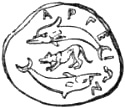
Coin of Ægina.
The dolphin and anchor is a famous historic symbol. Titus, Emperor of Rome, took the device of a dolphin twisted round an anchor, to imply, like the emblem of Augustus, the medium between haste and slowness, the anchor being the symbol of delay, as it is also of firmness and security, while the dolphin is the swiftest of fish. This device appears also upon the coins of Vespasian, the father of Titus. The anchor was also used as a signet ring by Seleneus, King of Syria. The dolphin and anchor was also used, with the motto “Festina lente” (“Hasten slowly”), by the Emperor Adolphus of Nassau, and by Admiral Chabot. The family of Onslow bear the same for crest and motto.
Aldus Manutius, the celebrated Venetian printer, adopted this well-known device from a silver medal presented to him by Cardinal Bembo, with the motto in Greek “hasten slowly.” Camerarius describes this sign in his book of symbols “to represent that maturity in business which is the medium between too great haste and slowness.” “When violent winds disturb the sea the anchor is cast by seamen, the dolphin winds herself round it out of a particular love for mankind, and directs it as with a human intellect so that it may more safely take hold of the ground; for dolphins have this peculiar property that they can, as it were, foretell storms. The anchor then signifies a stay and security whilst the dolphin is a hieroglyphic for philanthropy and safety.”
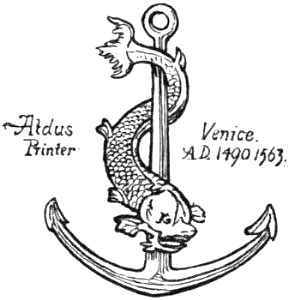
This sign was afterwards adopted by William Pickering, a worthy “Discipulus Aldi” as he styles himself. Sir Egerton Bridges has some verses upon it, amongst which occur the following:
“Would thou still be safely landed,On the Aldine anchor ride;Never yet was vessel stranded,With the dolphin by its side.·····“Nor time nor envy shall ever canker,The sign which is my lasting pride;Joy then to the Aldus anchorAnd the dolphin at its side.“To the dolphin as we’re drinking,Life and health and joy we send;A poet once he saved from sinking,And still he lives the poet’s friend.”The dolphin was the insignia of the Eastern Empire—the Empire of Constantinople. The Courteneys, a noble Devonshire family, still bear the dolphin as crest and badge, and the melancholy motto, “Ubi lapsus? Quid feci?” (“Whither have I fallen? What have I done?”), “a touching allusion,” says Miss Millington (“Heraldry in History and Romance”), “to the misfortunes of their race, three of whom filled the imperial throne of Constantinople during the time that city was in possession of the Latins after the siege of 1204. Expelled at length by the Greeks, Baldwin, the last of the three, wandered from Court to Court throughout Europe vainly seeking aid to replace him upon the throne.”
A branch of the imperial Courteneys settled in England during the reign of Henry II., and their descendants were among the principal Barons of the realm. Three Earls of Courteney perished on the scaffold during the Wars of the Roses; the family was restored to favour by Henry VII. Another Courteney, the Marquis of Exeter, became first the favourite, and subsequently the victim of the brutal tyrant Henry VIII. His son Edward, after being long a prisoner in the tower, ended his days in exile, and the family estates passed into other hands.
Sir William Courteney, of Powderham Castle, Devon (temp. Edw. IV.), bore emblazoned on his standard three dolphins in reference to the purple of three Emperors.
The Arms of Peter Courteney, Bishop of Exeter, 1478, is still to be seen in the episcopal palace environed with the dolphins of Constantinople.
The Dauphin of France
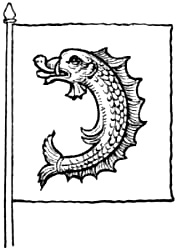
Banner of the Dauphin.
In France the bearing of the dolphin was exclusively restricted to the Dauphin or heir to the throne of the kingdom. Brydson mentions that one of the first of the troubadours was called the Dauphin, or Knight of the Dolphin, from bearing that figure on his shield, adding that “the name in his successors became a title of sovereign dignity.”
The title “Dauphin,” borne by the eldest son and heir-apparent of the kings of France under the Valois and Bourbon dynasties, originated in the Dauphins of Viennois, sovereigns of the province of Dauphiné. Guy VIII., Count of Vienne, was the first so styled. The title descended in the family till 1349, when Humbert II., de la Tour de Pisa, sold his seigneurie, called the Dauphiné, to Philippe VI. (de Valois), on condition that the heir of France assumed the title of “Le Dauphin.” The first French prince so called was Jean, who succeeded Philippe; and the last was the Duc d’Angoulême, son of Charles X., who renounced the title in 1830. In 1601, when Louis XIII. was born, there had not been a Dauphin since Francis II. (the husband of Mary, Queen of Scots)—eighty-four years. The province of Dauphiné sent a deputation to Fontainebleau, headed by the Archbishop of Vienne, to recognise the infant as their sovereign, and make him a present of an entire service of richly chased plate with various figures of dolphins, estimated at 12,000 crowns.
Grand Dauphin.—Louis, duc de Bourgogne, eldest son of Louis XIV., for whom was published the edition of the Latin classics entitled “Ad usum Delphini” (1661-1711).
Second, or Little Dauphin.—Louis, son of the Grand Dauphin (1682-1712).
Shakespeare, by an anachronism of a hundred years, introduced into King John
“Lewis, the Dauphin and the heir of France.”Mary Queen of Scots bore the title on her marriage in 1558 to the Dauphin, afterwards Francis II., and styled by her adherents:
“Mary, Queen, and Dolphiness of Fraunce,The nobillest lady in earth.”The Heraldic Dolphin
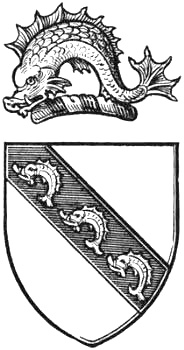
Example—Dolphin embowed.
The heraldic dolphin, as usually represented by modern heralds, is an ornamental monstrosity bearing but slight resemblance to the natural form of this celebrated historic marine symbol; a nearer resemblance to the natural shape is decidedly preferable. Some of the early heraldic representations, though a little crude, are very characteristic and thoroughly heraldic in treatment, though at the same time very unlike the real dolphin.
In its series of leaps out of the water the dolphin appears with high arched back, just as we see it represented in antique works; its natural shape, however, is straight, the back being but slightly curved. The broad tail paddle being placed in a horizontal position necessitates an up and down stroke, which makes their swimming to appear a series of leaps and divings. Like its near relative the porpoise, it is an air-breathing animal; its apparent gambollings on the water may, therefore, be more truly attributed to its breathing and blowing whilst in pursuit of its prey.
The Dolphin is generally, if not always, depicted in heraldry embowed, that is, having its back greatly incurvated. In blazon the word Dolphin, alone, implies that its natural position, naiant (swimming) and embowed, is understood, but for the sake of accuracy it is better always to give the description in full, as a doubt may arise as to the omission of a word indicating its position.
Torqued, torquend, torgant, or targant, from the Latin torquere, to twist, are old terms for embowed, or bowed embowed, bent in the form of the letter S, turning contrary ways at each bending; applicable also to serpents.
Hauriant, from the Latin ab hauriendo, is a term applied to fishes generally when placed in an upright position or in pale, as if putting the head above water to get air.

Shell-fish are blazoned erect or upright, the term hauriant being only applicable to fishes with scales and fins.
Urinant (from the Latin urino, to duck or dive under water) signifies borne with the head downwards and the tail erect, the reverse position of hauriant.
Two dolphins are occasionally borne together, sometimes endorsed, or back to back; sometimes respecting each other.
As signifying the conquest of the sea, it appears in the shields of many seaport cities. It figures on the well-known bearings of the towns of Brighton, Dunkirk, Poole, &c.
The Dolphin appears in English heraldry as early as the middle of the thirteenth century. In a roll of arms of that date, a dolphin is given as the coat of Gile de Fiseburn.
“The Godolphins of Helston,” says Miss Millington, “who had estates in that part of the kingdom (Cornwall) at the time of the Conquest, bore argent three dolphins embowed, sable.” Similar arms are borne by many English families.
The Godolphins, Franklins, Franklands, Frenches, Fishers and Kennedys, in many of their branches, bear the dolphin fish as their crest.
A man playing the harp on a dolphin is the heraldic cognisance of the Walterton family.
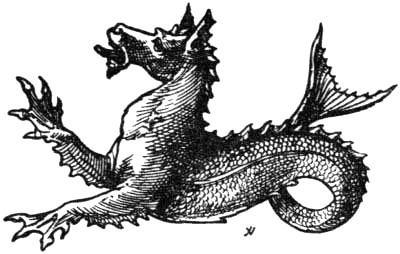
Sea-horse naiant.
The Sea—Horse
“His sea-horses did seem to snort amainAnd from their nostrils blow the fiery streamThat made the sparkling waves to smoke againAnd flame with gold; but the white foam creamDid shine with silver, and shoot forth his beam.”Spenser’s Faerie Queen.(Procession of the Sea Divinities.)The steeds of Neptune are favourite subjects in ancient poetry and art in the triumphs and processions of the marine deities, drawing the chariot of the sea-god in its progress through the waves. The imaginative Greeks pictured to themselves the horses of Poseidon in the rolling and bounding waves as they pursue each other in haste towards the shore, “curling their monstrous heads.” This may seem to account for the constant and close connection between the god and the horse. The origin of the horse is ascribed to the contest between Poseidon and Athenæ as to who should make to mankind the most useful present; Neptune created the horse, Minerva the olive-tree.
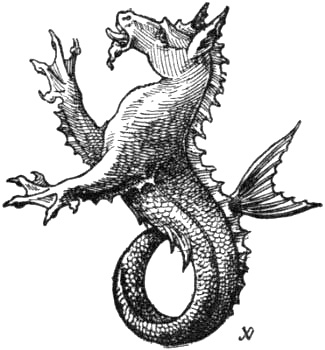
Sea-horse erect.
The city of Lampsacus, in Mysia, founded by the Phoceans, adopted the winged sea-horse as their monetary type, in allusion to the fleetness of their vessels. Others of the maritime States of Greece also adopted the sea-horse upon their coins.
A coin of the celebrated Pyrrhus, King of Epirus (slain b.c. 272), the knight-errant of ancient heroes, represents the head of Achilles, the reputed ancestor of Pyrrhus, on one side, and the Nereid, Thetis, the mother of Achilles, on the sea-horse on the reverse. Thetis carries the arms forged by Vulcan for Achilles, in allusion to the succour brought by Pyrrhus to the Italian Greeks against the barbarians, as the rising Romans were termed by them.
In Gibbon’s “Decline and Fall of the Roman Empire,” we find a reference to a veritable sea-horse, if we may believe our authority. John Sobieski, the victorious King of Poland, in his letters to his wife, when he raised the memorable siege of Vienna and delivered Europe for ever from the incursions of the Turks, describes to her how, in the tent of Mustapha, he found the great standard of the Turks, “made of the hair of the sea-horse (?) wrought with a needle and embroidered with Arabic figures.” It was afterwards hung up by the order of the Emperor in the Cathedral of St. Stephens, “where,” adds the historian, “I have seen it.”



